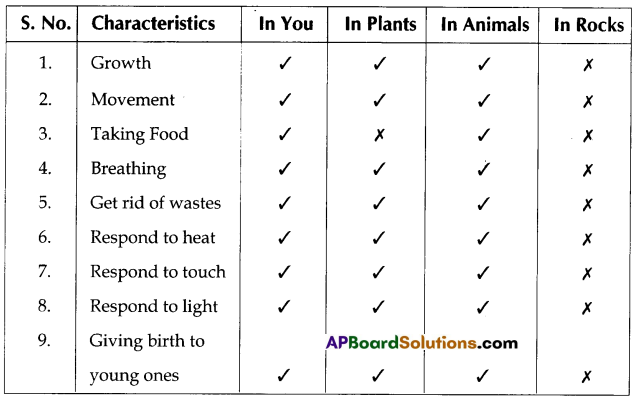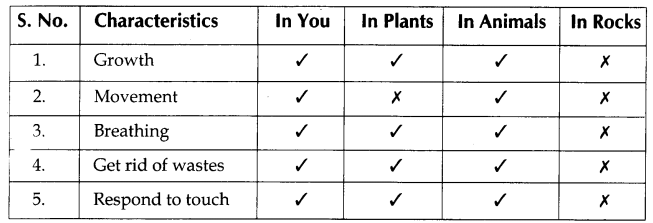These TS 6th Class Science Important Questions 16th Lesson Living and Non Living will help the students to improve their time and approach.
TS 6th Class Science Important Questions 16th Lesson Living and Non Living
Question 1.
What is photosynthesis ?
Answer:
By using carbondioxide, green colour substance (chlorophyll) in the leaves and sunlight plants prepare their own food. This is called photosynthesis.
![]()
Question 2.
Explain how bacteria are harmful.
Answer:
Some bacteria cause diseases in human beings as well as animals and birds. These bacteria spread from one person to the other and cause various types of diseases. They spread all over the world. There is no place in the world without bacteria.
Question 3.
Read the given names. Observe their movements and tabulate the information.
a. Yourself
b. Housefly
c. Grasshopper
d. Frog
e. Snake
f. Birds
g. Fish
h. Plant.
Living Organisms Means of motion
| Living Organisms | Means of Motion |
| Myself | Walk, run |
Answer:
| Living Organisms | Means of Motion |
| Myself | Walk, run |
| Housefly | Walk, fly |
| Grasshopper | Hopping, fly |
| Frog | Jump, swim |
| Snake | Crawls |
| Birds | Walk, fly |
| Fish | Swim |
| Plant | Never move |
Question 4.
Write the differences between viviparous and oviparous animals.
(or)
How do you differentiate viviparous animals from oviparous animals.
Answer:
| Viviparous animals | Oviparous animals |
| 1 Animals give birth to young ones directly 2. These feed young ones with milk on their own Eg: Man, goat |
1. Animals lay eggs and develop the young ones 2. They bring food from outside and feed the young ones Eg: Birds |
Question 5.
Define the following (A) Oviparous (B) Viviparous.
(or)
What are oviparous animals ? What are viviparous animals ? Give examples.
Answer:
- Oviparous animals : Organisms that lay eggs for giving birth to young ones are called oviparous animals. Eg : Birds
- Viviparous animals : Organisms which give birth to the young ones are called viviparous animals Eg : Goat, sheep.
![]()
Question 6.
Mention some examples of egg laying animals.
Answer:
Duck build Platypus, Crocodile, Snake, Fish, Lizard, Tortoise etc.
Question 7.
Explain the differences between living and non living things.
Answer:
| Living things | Non-living things |
| 1. Possess life and different systems such as respiration, circulation, reproduction etc. | 1. Do not possess life. No systems in them. |
| 2. Locomotion is seen. | 2. No movement is seen |
| 3. Growth occurs | 3. No growth is seen |
| 4. Give birth to young ones through reproduction | 4. Can’t produce anything |
| 5. Create sense and respond to the nature Ex: Man, animals. | 5. Can’t create any sense and respond to the nature. Ex: Stone, soil etc. |
Question 8.
How do the living organisms respond to the stimulus? Explain with examples.
Answer:
- Some plants respond to the stimulus.
- For example when we touch the leaves of “Atti – Patti” plant, some action generates in them.
- Immediately all the leaves get folded themselves.
- Some plants bloom in the morning and some at night. These respond to sunlight.
- When winter comes many trees shed their leaves.
- All the animals respond to external stimulus.
- For example we wear woollen clothes in winter and cotton clothes in summer.
- Some animals search for food during night and majority of animals search for food during day time.
- Respond to the external stimulus makes the plants and animals survive, obtaining food, protecting themselves etc.
Question 9.
Harika says catis a living organism. Based on which characters does Harika say like that?
Answer:
- Cat moves from place to place
- Cat eats food, digests and excretes wastes
- It gives birth to young ones.
- It catches prey and eats.
- It saves itself from enemies.
Question 10.
What would happen if there is no phenomenon of stimulus and response in the nature?
Answer:
Stimuli and responses are the special features in the nature. If stimulus – response is lacked in the nature, animals cannot defend their life from many dangers.
Man can’t obtain food, classify the works and change the life activities without stimulus and response.
![]()
Question 11.
Generally our elders say that we should not put wet spoons in pickle jars. Why do they say this ?
Answer:
When we put wet spoons in a pickle jar, the pickle will spoil. Wet spoon carries fungus (harmful microbes) which spoil the food material.
Question 12.
What happens when you pack bread or vegetables and keep for a couple of days ? What do you observe from bread?
Answer:
We notice that the stored bread or vegetables become rotten and emits a foul smell. We can see thin, thread like grey colour substance on the material. After a few days this grey colour substance turns black. If rotten material is observed under microscope we see fungi called bread mold.
Question 13.
Read the following characteristics.
a. Growth
b. Movement
c. Taking food
d. Breathing
e. Get rid of wastes
f. Respond to heat
g. Respond to touch
h. Respond to light,
i. Giving birth to young ones.
|
S.No |
Characteristics | In You | In Plants | In Animals | In Rocks |
| 1. | Growth | ✓ | ✓ | ✓ |
✓ |
Answer:

Question 14.
Write the observations of stimuli – responses you made in the Atti-patti plant.
Answer:
Atti-patti plant leaves have pad-like swellings at the base called pulvini. It has water content. Due to water pressure, the leaf base holds the leaf erect. When we touch the leaves, an electrical impulse is generated. This impulse acts on plant substances. Immediatel, water content at the leaf base makes the leaves fold.
![]()
Question 15.
Write the simple experiment you conducted to observe the stimulus and response in the animals.
(Or)
How can you show that the animals respond to light (by earthworms)?
Answer:
An earthworm is placed in the glass jar containing soil. Half of the bottle is covered with black paper. The mouth of the bottle is covered (closed) with lid which contains small holes. Holes allow the air into the bottle.
Observation : Earthworm tries to come out of covered portion. When light falls on the bottle, the worm tends to move up towards the cream in which light does not fall.
Result : With this, we can say that the animals respond to the stimulus. In this experiment light is stimulus and movement of earthworm away from light is response.
Question 16.
How do you see bacteria under a microscope with the help of available material such as curd?
Answer:
Watery substance of curd is taken. A drop of fluid is put on the glass slide. It is covered with another slide. The preparation is kept under microscope.

Observation : The micro organisms that we see are bacteria. The bacteria is Lacto bacillus.
Question 17.
How did you prepare your own microscope to see the smaller organisms?
Answer:
One used electric bulb is collected. Its filament is removed. Half of the bulb is filled with water.
Water and glass bulb magnifies the object that is seen through it. Microscope is ready.
Question 18.
Discuss with your friend how we would respond in the conditions given here.
a. When you step on a sharp object
b. Touch a flame or fire
c. Touch ice-cream
d. See a bright light
e. Get bitten by an ant or mosquito
f. When you hear about tamarind or lemon.
Answer:
| Stimulus | Response |
| When you step on a sharp object | We feel burning sensation |
| Touch a flame or fire | We feel burning sensation |
| Touch ice-cream | We feel cold and freezing |
| See a bright light | Blink |
| Get bitten by an ant or mosquito | Feeling piercing sensation |
| When you hear about tamarind or lemon | Mouth waters, |
Question 19.
Observe the following table and answer the given questions.
Answer:

a. In which of the above table you find growth?
Answer: Man, plants and animals.
![]()
b. What are the characteristics that are same in plants and animals?
Answer: Growth, breathing, getting rid of wastes and responding to touch.
c. Do plants and animals possess the same characteristics as you do?
Answer: Yes, except in movement.
d. Which things are called living things?
Answer: Things which have life are living things.
Ex : Plants and animals.
Question 20.
Write responses to the following stimuli.
Answer:
| Stimulus | Response |
| 1. Touching the fire | Withdraw hand immediately |
| 2. See bright light | Blinking eyes |
| 3. Mosquito bite | Scratching the place of bite |
| 4. Heard of Tamarind and Lemon | Mouth waters |
| 5. Touch Ice Cream | Withdraw hand immediately |
| 6. Touch the touch me not plant | Leaves folded |
| 7. Keeping the seeds in wet soil | Germinated |
| 8. When heard big sound | Closing ears |
Question 21.
Make a group with 4 or 5 students. List out birds and animals from your surroundings. How do they produce their young ones ? Write in a table whether they lay eggs or give birth to young ones.
We, the students visited our surroundings. We observed the following animals and birds. We came to understand about the egg laying birds and young ones giving animals. The information is tabulated below.
- Hen
- Crow
- Sparrow
- Dog
- Cat
- Rat
- Buffalo
- Cow
- Duck
- Crane
- Blue Jay
- Goat.
Answer:
| Animals/birds that lay eggs | Those who give birth to young ones |
| Hen | Rat |
| Sparrow | Dog |
| Duck | Cat |
| Crane | Cow |
| Blue Jay | Buffalo |
| Crow | Goat |
Question 22.
Draw the diagram showing stomata in plants observed by you. Write its use.
Answer:

Question 23.
Draw a neat labelled diagram of Microscope.
Answer:

Question 24.
What efforts and qualities of scientists do you appreciate?
Answer:
- Scientists invented microscope to observe micro organisms.
- With the help of microscope man is able to diagnose the diseases.
- Human beings feel flexible and easy by utilising modern equipment created by scientists.
- Ever scientist contributed and sacrificed his life to make the world enter into a modern age.
![]()
Question 25.
What are the man made activities that cause harm to the environment?
Answer:
The following are the man made activities that cause harm to the environment.
- Deforestation
- Releasing wastes from the industries
- Over using chemicals and fertilizers in the crop – field.
- Destroying fertiLe crop – field and convert it into concrete buildings.